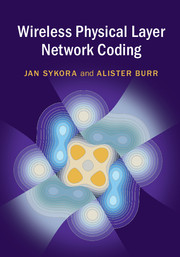Book contents
- Frontmatter
- Contents
- Preface
- Mathematical Symbols
- Abbreviations
- Part I Motivation and Gentle Introduction
- Part II Fundamental Principles of WPNC
- Part III Design of Source, Relay, and Destination Strategies
- 6 NCM and Hierarchical Decoding Design for H-MAC
- 7 NCM Design and Processing for Parametric Channels
- 8 NCM Design for Partial HSI and Asymmetric H-MAC
- 9 Joint Hierarchical Interference Processing
- 10 WPNC in Complex Stochastic Networks
- Appendix A Background Theory and Selected Fundamentals
- References
- Index
8 - NCM Design for Partial HSI and Asymmetric H-MAC
from Part III - Design of Source, Relay, and Destination Strategies
Published online by Cambridge University Press: 01 February 2018
- Frontmatter
- Contents
- Preface
- Mathematical Symbols
- Abbreviations
- Part I Motivation and Gentle Introduction
- Part II Fundamental Principles of WPNC
- Part III Design of Source, Relay, and Destination Strategies
- 6 NCM and Hierarchical Decoding Design for H-MAC
- 7 NCM Design and Processing for Parametric Channels
- 8 NCM Design for Partial HSI and Asymmetric H-MAC
- 9 Joint Hierarchical Interference Processing
- 10 WPNC in Complex Stochastic Networks
- Appendix A Background Theory and Selected Fundamentals
- References
- Index
Summary
Introduction
As shown in Chapter 5 in general, and in Chapter 6 in more concrete forms, the design of NCM is relatively straightforward and its performance provides an advantage only under specific conditions. It particularly applies to the form of HNC maps and some requirements on the SNR balance of component channels in H-MAC. For example, the isomorphic layered NCM for HDF strategy gives an H-rate advantage if the HNC map is a GF-based linear minimal cardinality map and the component channels have roughly the same SNRs. When applied for example to a butterfly network, it implies symmetric distances on the source-to-relay channels and a perfect HSI with the same rate as the H-rate at the relay. All relays that use a minimal cardinality linear GF HNC map must be on the same GF vector space as the source messages. The resulting equations and therefore also the HI processed by the relay have the same codebook size as the component messages. Similarly, CF strategy requires a common nested lattice code on sources and the HNC map also implies that all flows of hierarchical information from relays to the destination will have the same codebook size.
Clearly, many practical WPNC networks will need to operate with asymmetric SNR conditions or asymmetric parametrization on the H-MAC, and also the destination might have available only a limited HI or HSI (w.r.t. source codebook sizes) to compute the desired data. The “brute force” solution is to use minimal common source rates, which are bottlenecked by the weakest channel, either on the H-MAC or on the HSI side. This chapter, however, offers a solution allowing us to design NCM for partial HSI and asymmetric H-MAC. It is based on splitting the source data streams into several lower-rate independent components. The split sources can be viewed as virtual component nodes. The split allows us to use different strategies for selected virtual components. We can also group a selected subset of virtual nodes and apply a given strategy that matches to the selected group. For example, we can use layered NCM for the group of virtual nodes having the same rate and having a similar SNR. We can form multiple groups in this way and combine them by another coding strategy. For example, if the groups have very asymmetric rates or SNRs, we can use a classical multi-user strategy.
- Type
- Chapter
- Information
- Wireless Physical Layer Network Coding , pp. 226 - 250Publisher: Cambridge University PressPrint publication year: 2018



